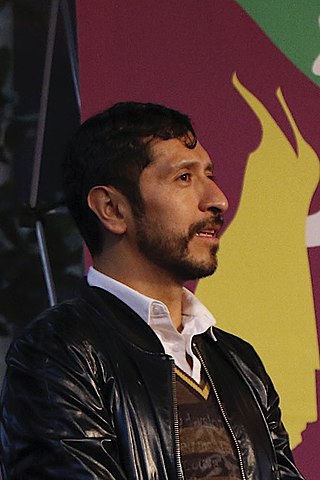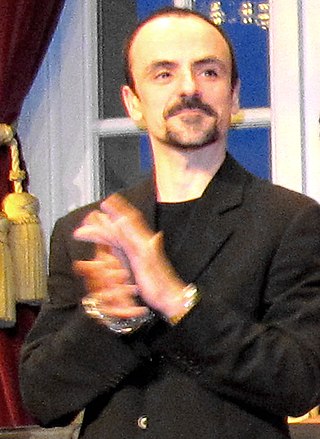
Trujillo is a city in coastal northwestern Peru and the capital of the Department of La Libertad. It is the third most populous city and center of the third most populous metropolitan area of Peru. It is located on the banks of the Moche River, near its mouth at the Pacific Ocean, in the Moche Valley. This was a site of the great prehistoric Moche and Chimu cultures before the Inca conquest and subsequent expansion.

Marinera is a partner dance that originated along the coastal regions of Peru, using handkerchiefs as props. The dance is a mix of Spanish contradanza and Andean zamacueca, and is a stylized reenactment of a courtship, showing a blend of the different cultures of Peru. The dance has gained recognition throughout South America and is known as the most prominent traditional dance of Peru. The city of Trujillo has been recognized as the national birthplace of the marinera since 1986. The Marinera Festival, a cultural event dedicated to marinera held in Trujillo, has held annual competitions of the dance since 1960. In 2012, the Congress of Peru observed nationally October 7 as a commemorative day for the marinera.
The Morenada is an Andean folk dance whose origins are still under debate. This dance is practiced mainly in Bolivia as well as in Peru and in recent years with Bolivian immigration in Chile, Argentina and other countries.

Víctor Larco Herrera also called commonly Víctor Larco is a district and a city of the north coast of Peru. It is located on a plain along the Pacific Ocean and is linked by a conurbation with Trujillo in La Libertad region. It is considered one of the 9 districts of the urban area known as Trujillo Metropolitano, one of the most populous metropolitan areas of Peru; it is also one of the 11 districts of Trujillo province. Victor Larco is the district that has the highest human development index (HDI) out of Lima Metropolitana, according to a study published by the United Nations Development Programme. In the early twentieth century, for its mild climate and fresh, it was known as Buenos Aires and then in 1945 got the name of Victor Larco Herrera in memory of the illustrious philanthropist Trujillan who was a benefactor of the city.
Laura Urdapilleta was primaballerina of the national Mexican dance company, known as the "Ballerina of Mexico".

The Diablada, also known as the Danza de los Diablos, is an Andean folk dance performed in the Altiplano region of South America, characterized by performers wearing masks and costumes representing the devil and other characters from pre-Columbian theology and mythology. combined with Spanish and Christian elements added during the colonial era. Many scholars have concluded that the dance is descended from the Llama llama dance in honor of the Uru god Tiw, and the Aymaran ritual to the demon Anchanchu, both originating in pre-Columbian Bolivia, though there are competing theories on the dance's origins.

Luis Pereyra is a dancer and choreographer of Tango Argentino and Argentinian folk dances.
The Mexcaltitán Ballet was founded in 1989 by choreographer Sergio Eugenio García Pérez and is based in the western state of Nayarit in Mexico. It was founded to promote and consolidate Mexican folk dance, with a focus on the state of Nayarit, making it unique. However, the troupe also performs other dance from Latin America and contemporary dance as well as Mexican styles. The dancers are young and trained by the company to perform. The organization is divided into two sections, the main group and a children’s group called the Mexcaltitán Infantil, geared to very young dancers with the aim of training them to become part of the main group. Today, the troupe is supported by the Nayarit state government and García Pérez remains as the general director.
La Cebra Danza Gay is a dance troupe founded in 1996 by José Rivera Moya in Mexico City. It is the first in Mexico to focus nearly exclusively on gay community and the issues it faces. The groups as a repertoire of over ten major works including Danza del mal amor o mejor me voy, which has been performed over 100 times. La Cebra has appeared in various locations in Mexico and has had appearances in the United States and France.

Antonio Salinas is a Mexican dancer, choreographer and stage actor. He has studied and collaborated with Mexican and international artists and has taught in a number of universities at home and abroad. In 1999, he was named one of the best dancers in Mexico by Zona de Danza.
Laleget Danza is an international dance company based in Mexico City which was founded by Diego Vázquez in 2005. It has performed in Spain, United Kingdom, Netherlands, Slovakia and Curaçao. It has appeared in various theaters and festivals in Mexico including the Festival Internacional Cervantino in 2008 and 2011.
The Trujillo Spring Festival is a festival and cultural event that takes place in the Peruvian city of Trujillo, between the end of September and beginning of October each year. This spring festival is considered one of the most representative of Trujillo city and honors its nickname of City of the everlasting spring. This festival is also one of the largest in the country and attracts the attendance of thousands of tourists from around the planet. The main attraction of this festival is a traditional Corsican or spring parade, involving mainly beauty queens of Lions clubs across the continent; in the parade there's a competition in the decoration about spring allegory and to be honored with the award called the gold lion. It is organized by the Lions Club of Trujillo.

Trujillo Marinera Festival is a Peruvian cultural event held annually in Trujillo city in January. The event focuses on a dance contest called the marinera, a typical dance of the city and of the country. The festival also presents parades, presentations and competitions of Peruvian paso horses. Both the marinera dance and the Peruvian paso horse have been declared to be part of the cultural heritage of the nation by the Peruvian government. This festival is one of the most important cultural events and representative of the country and Trujillo city has been recognized by the Peruvian government as the National Capital Marinera by Law Number 24447, of January 24, 1986.

Trujillo Book Festival is an international literary festival held in Trujillo, a Peruvian city. The last edition in 2012 took place on March from days 1 to 12 in the Plazuela El Recreo an historical square of the city and had the participation of Peruvian writers as Arturo Corcuera and Jorge Diaz Herrera, writer honored, and also the young Colombian poet Lucia Estrada

Ballet Folklórico de Honduras Oro Lenca is a Honduran folkloric ballet troupe in La Esperanza. It was founded in 2008 and presents dances and costumes that reflect the traditional culture of Honduras. This dance troupe hosts an annual folk dance festival, El Grande de Grandes, and represents Honduran culture internationally. It also mentors nascent dance groups in villages, towns, and cities of Honduras. In November 2015, the National Congress of Honduras designated Ballet Folklórico Oro Lenca Patrimonio Cultural de la Nación, and subsequently designated Ambassadors of Art and Culture by executive decree.

Goyo Montero Morell is a Spanish ballet dancer, a ballet director and a choreographer.

Ileana Leonidoff is a pseudonym for Elena Sergeevna Pisarevskaya, a Russian-born emigrée who first made a career in Italy in silent films and then as a noted dancer and choreographer. She was the founder and lead dancer of the Dance School of Teatro dell'Opera di Roma. During World War II, she fled to South America, first teaching in Argentina and then in Ecuador in 1950. She was the first director of the Ballet Oficial de Bolivia, then served as the director of the Guayaquil Ballet in Ecuador, and became the founder of the Ballet School of Trujillo, Peru. She was honored as a knight of the Order of the Condor of the Andes in 1953.

Teresa Mann was a Panamanian ballerina, ballet teacher and dance pioneer. She was a founding member of the Ballet Nacional de Panama and its lead dancer until 1983. She was also the founding director of the Escuela de Danzas Teresa Mann and the Ballet de Teresa Mann in Panama.

Cecilia Lugo is a Mexican contemporary dancer and choreographer. She has participated in groups such as INBA's National Dance Company and the Ballet Folklórico de México.

Vania Masías Málaga is a Peruvian dancer and choreographer. She is founder and president of the D1 Cultural Association.















